This is my last article (for now) in a series about macro photography using C-mount cine lenses. (The first article is here and the second is here.) In the first, I tried three experiments, one of which involved extreme close-ups of toy marbles. And I was surprised at how much people enjoyed it! So I decided to devote a third article to just marbles.
But this time, I wanted to photograph a few more favorites from my childhood collection. Ones that are also more opaque than those I shot before. And I wanted to show entire marbles this time in my X-Pro1’s APS-C frame… rather than extreme close-ups.
A Different Setup
Early tests showed that this would be fairly difficult because:
- Using my earlier setup, opaque marbles illuminated by a light table below them would become featureless black disks in photos. I’d have to use more distant lighting above my subjects.
- This also meant that I couldn’t use the unique external helicoid tube that enabled fine focusing in my 110-film-scanning article.
- And with more distant light sources, I’d be working with lower light levels than before. So I’d need to use my Kern-Pallard Switar 25mm f/1.4 lens rather than the Bausch & Lomb 25mm f/2.7 Animar Balcote.
The featured image above shows the final setup. From left to right:
- A cable release minimized camera shake.
- I reduced magnifications by mounting a shorter M39 lens adapter to the camera front.
- A small plastic washer below the M39 adapter kept the camera horizontal.
- Thick white mounting tape held the C-mount lens onto the M39 adapter (with a strong but reversible hold). The pieces of tape you see are the only things holding the lens on the camera!
- I mounted marbles on a micro-plinth made from a toothpaste-tube cap with a small plastic washer inserted in its top.
- A CD jewel case below the plinth was just thick enough to center marbles vertically in the camera’s frame.
- My light table stayed dark, but it provided a slick glass stage for easily sliding the jewel case around horizontally to achieve optimum positioning and focus. (I did not move the camera to focus.)
- And on the far right, a piece of black cardboard provided an uncluttered background.
But There was Something Else…
I also realized that my previous shots probably struck a chord because people fondly remembered playing with marbles as kids. I too had marbles as a child of the ‘50s, but don’t really share the same memories because I was rarely allowed outdoors to play. And in fact, I know very little about the marbles I still have. So I decided to research these “favorites” as I photographed them. And I hope you’ll enjoy what I learned.
One of the first findings surprised me. Growing up in Ohio, I did not realize that I was living in the beating heart of American marble-making! This Wiki page lists 21 U.S. companies that produced “machine-made” marbles from 1904 to the present day. The vast majority of these firms were located in Indiana, Illinois, Ohio, Michigan and especially, West Virginia. This wasn’t because the American midwest had better sand for making glass, but instead, because those states had better access to the natural gas that could fire flames to turn sand into glass. (This is also why much of the “Depression Glass” that people still collect came from Ohio.)
But military demands for natural gas during two World Wars gradually forced 11 of these firms to close by the 1950s. And all but three of the remaining manufacturers shut down after that. These survivors include the big kahuna, Marble King, which still makes toy and decorative marbles… plus “industrial” marbles used in air- and water-filtration systems and as “agitators” in aerosol products like hair sprays and spray paints. The two other listed manufacturers still in business happen to be artisan studios: Sammy’s Mountain Marbles and Dave’s Appalachian Swirls (no relation).
NOTE: In the world of toy marbles, any Wiki page must be incomplete. So if you know any other major U.S. manufacturers that are still in business, let us know in a comment!
Now Meet My Little Friends
This first marble has long been a favorite because it’s just so weird! NOTE: All photos were lit by ceiling track lights, and taken at 1 second, f/8, ISO 800. Except for the last marble, all of these orbs are “regular-sized.” And my only post processing was to expand R-G-B channels across their full tonal ranges using an image editor’s histograms. After that, the images needed no further brightening:
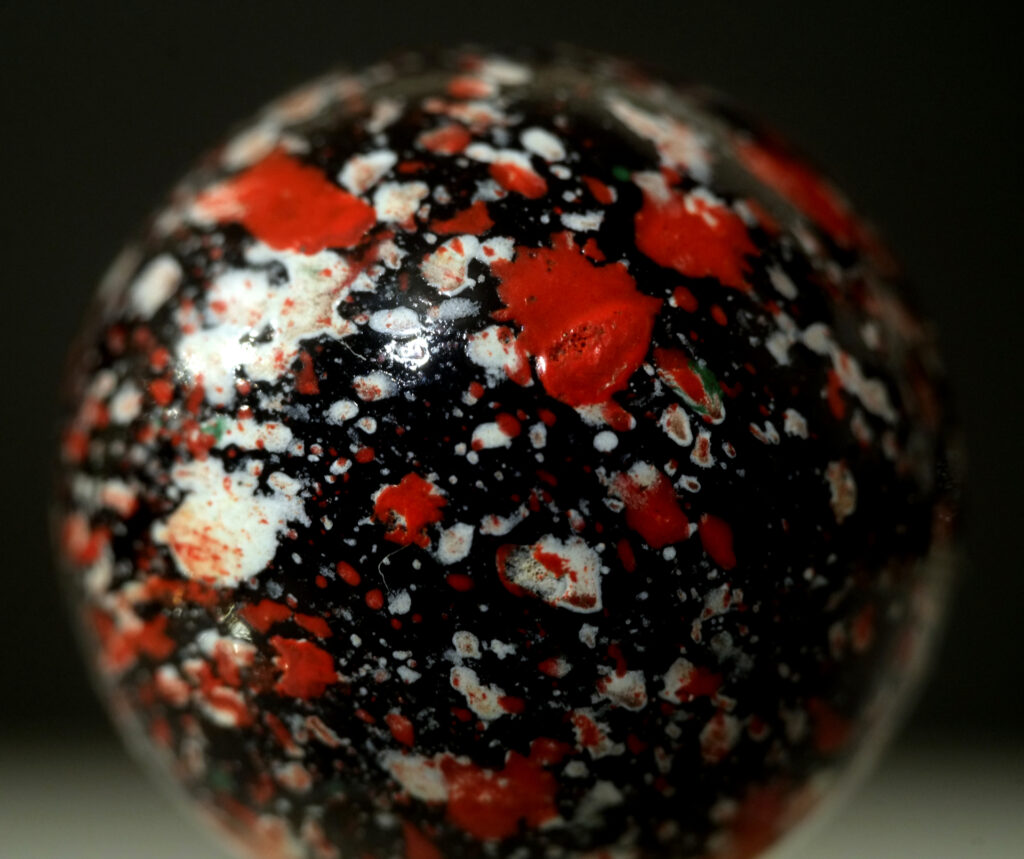 I’ve seen marbles like the above called “Confetti,” “Meteor” and even “Showflake.” But “Glitterbomb” seems more appropriate when a marble’s base glass is 100% opaque black. Like most machine-made marbles, its production required a little up-front hand work. A technician collected an appropriately sized “gob” of molten glass of a desired color and rolled it across a bunch of colored glass flecks. They clung to the gob’s surface, briefly melted into it, and then (as with most machine-made marbles) the gob was dropped onto ribbed rollers that molded it into a perfect sphere as it cooled.
I’ve seen marbles like the above called “Confetti,” “Meteor” and even “Showflake.” But “Glitterbomb” seems more appropriate when a marble’s base glass is 100% opaque black. Like most machine-made marbles, its production required a little up-front hand work. A technician collected an appropriately sized “gob” of molten glass of a desired color and rolled it across a bunch of colored glass flecks. They clung to the gob’s surface, briefly melted into it, and then (as with most machine-made marbles) the gob was dropped onto ribbed rollers that molded it into a perfect sphere as it cooled.
Since these Glitterbombs were often made from glass scraps accumulated during the day, they have also been called “End-of-Day” marbles. And it’s therefore hard to attribute this example to any specific manufacturer.
NOTE: The lens’s f/8 aperture brought a decent amount of the subjects into focus.
Next are two non-glass orbs:
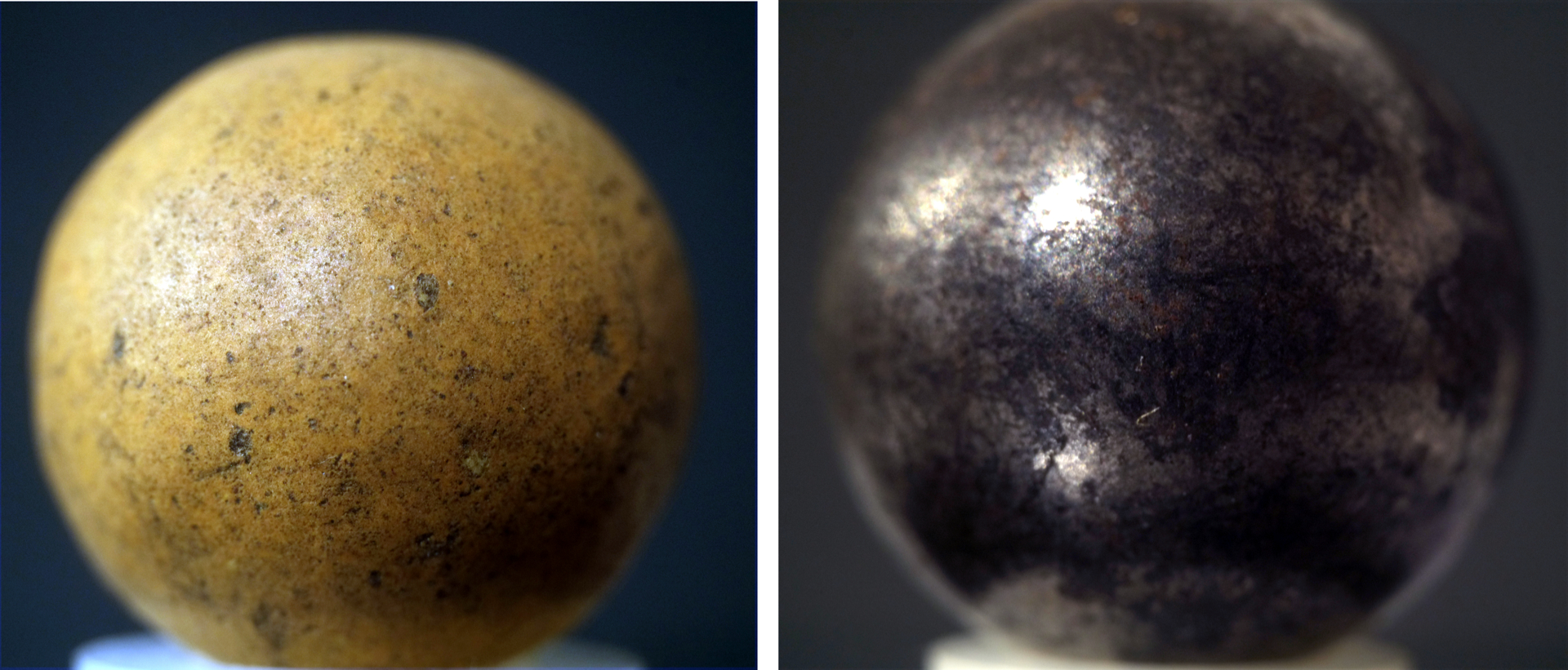 Many people– myself included– might have called the one on the left a clay bullet from the Civil or Revolutionary War. But it’s not. According to this site, hand-made munitions from early U.S.wars either had heavy lead cores within their clay exteriors or lead cladding around clay or porcelain centers– to help them survive the firing process. But if I tried to shoot my solid-clay marble at someone, I’d end up sand-blasting them.
Many people– myself included– might have called the one on the left a clay bullet from the Civil or Revolutionary War. But it’s not. According to this site, hand-made munitions from early U.S.wars either had heavy lead cores within their clay exteriors or lead cladding around clay or porcelain centers– to help them survive the firing process. But if I tried to shoot my solid-clay marble at someone, I’d end up sand-blasting them.
Even further back in time, hand-made clay marbles had been used in ancient Egypt. But I found mine around 60 years ago in Tennessee, and it may well have been made by Native Americans or early colonists or soldiers.
Also above, on the right, is a well-used metal “steelie.” It might even have served as a ball bearing rather than a game piece. But it certainly has patina now. And it is magnetic.
Next, are two colorful spheres:
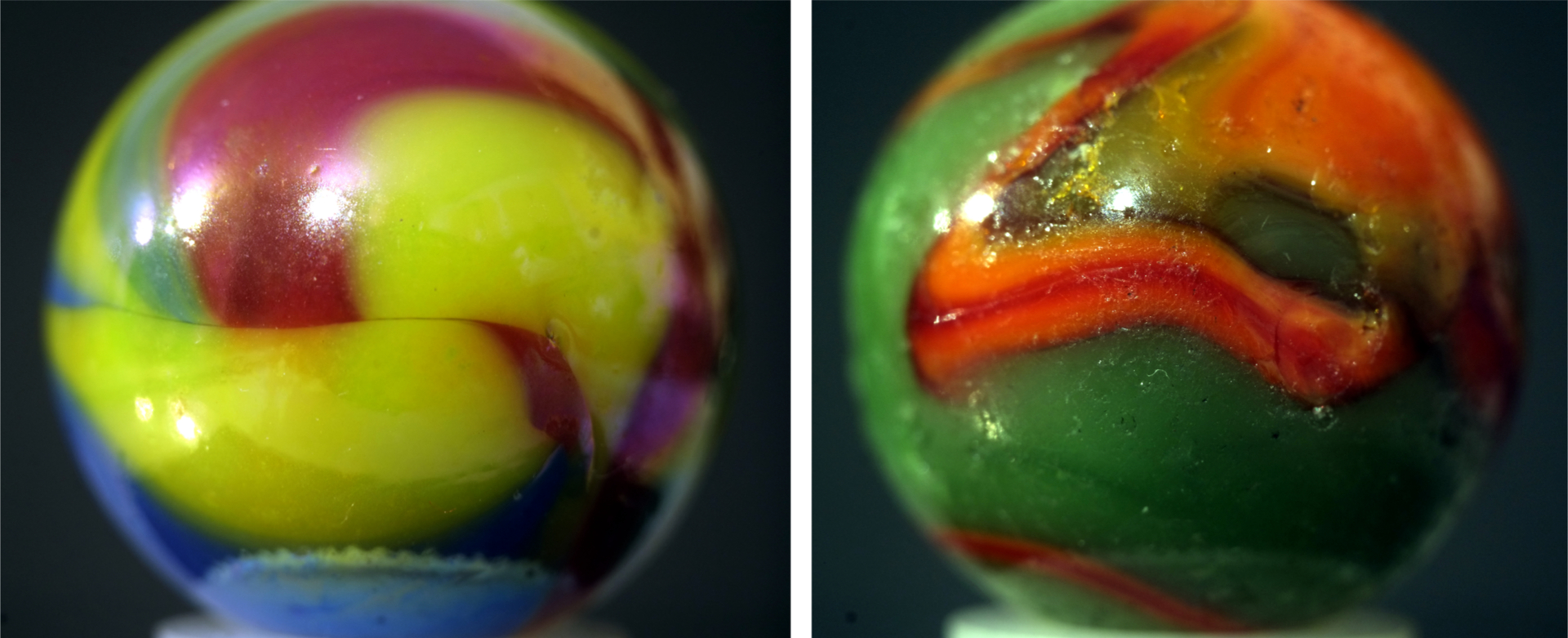 The straight “fold” line in the one on the left is a possible characteristic of a Peltier production. And with all its colors, it could be from their “Rainbo” line. Or it could be an Akro Agate. Maybe. Interestingly, if it didn’t include green, its red-yellow-blue tones would also make it a “Superman” marble (after the caped hero’s colorful costume).
The straight “fold” line in the one on the left is a possible characteristic of a Peltier production. And with all its colors, it could be from their “Rainbo” line. Or it could be an Akro Agate. Maybe. Interestingly, if it didn’t include green, its red-yellow-blue tones would also make it a “Superman” marble (after the caped hero’s colorful costume).
And the dense contrasty colors of the well-used orb on the right may make it an older Akro Agate. Or not… I can’t be sure. But I like its saturated oranges and greens. It seems that, in general, collectors love marbles with multiple bright colors. And those two certainly qualify.
Below is a colorful planetoid with lots of “flow” and a few opportunities to peer into its dense cloud cover. I have no idea who made it, but if you do, please comment!:
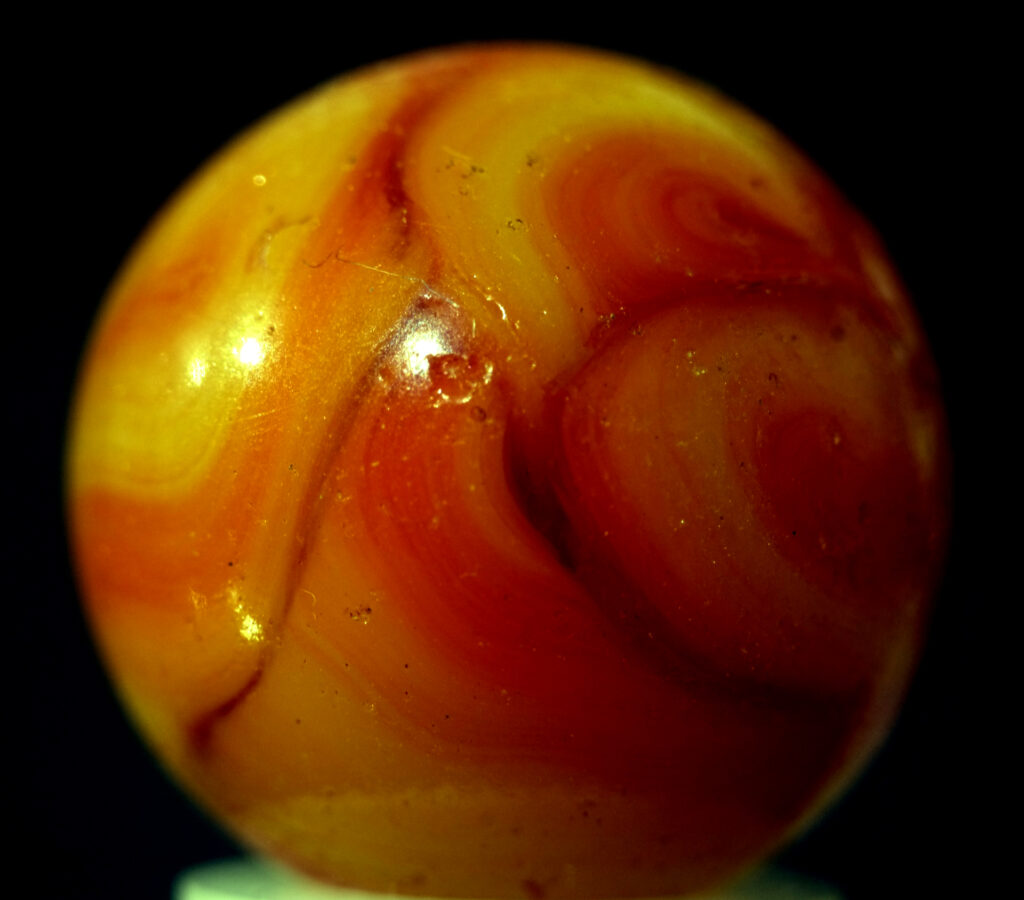 Here are two views of another beautiful planetoid, with wider views into its interior through “swirly” cloud banks. Like the above marble and the two blue ones further down, it may also be called a “slag” (due to its swirling colors) :
Here are two views of another beautiful planetoid, with wider views into its interior through “swirly” cloud banks. Like the above marble and the two blue ones further down, it may also be called a “slag” (due to its swirling colors) :
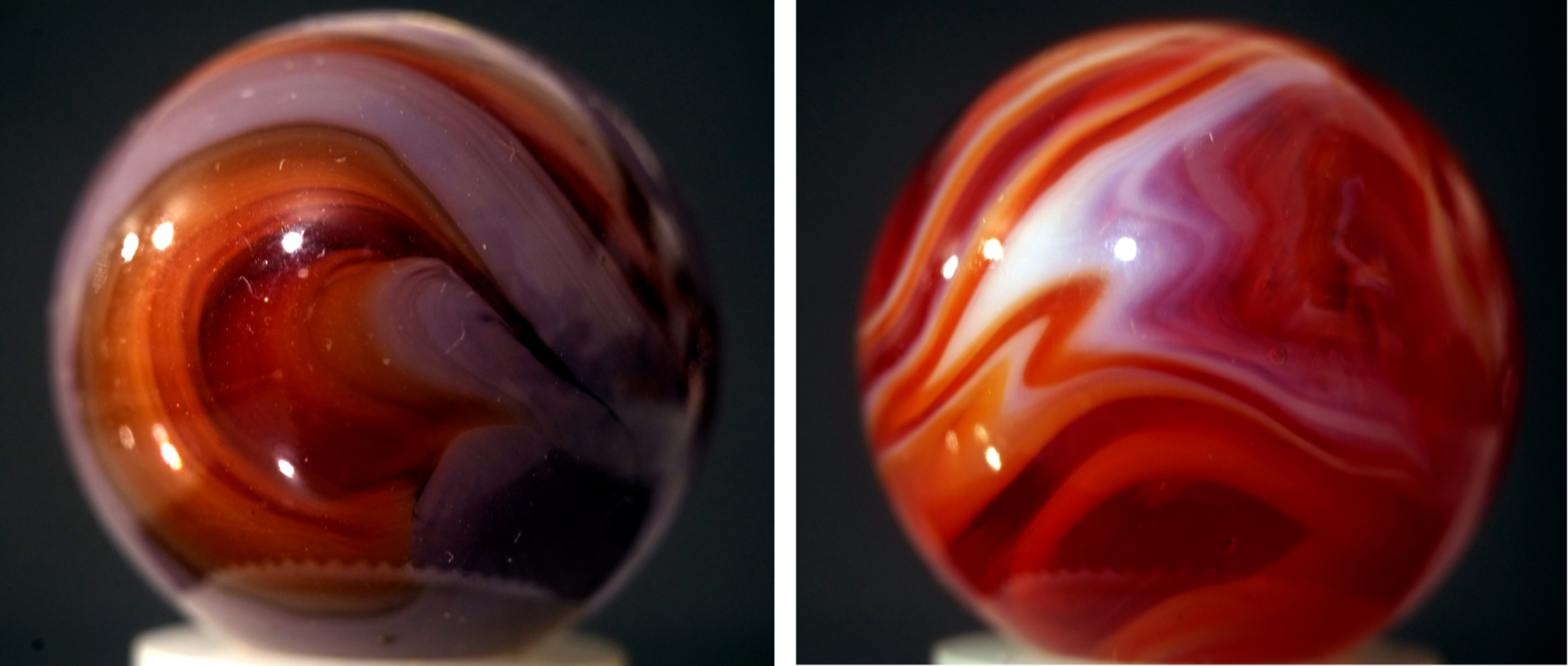 Next are two nearly identical “swirls.” The one on the right might also be called a “Corkscrew 9-Tail” because a single flow line winds around the marble between its pontil poles. And with a head shaped like the number 9 or a comet (visible at the bottom) and a pointed tail at the other end (just outside of view at the top), it could be another Akro Agate:
Next are two nearly identical “swirls.” The one on the right might also be called a “Corkscrew 9-Tail” because a single flow line winds around the marble between its pontil poles. And with a head shaped like the number 9 or a comet (visible at the bottom) and a pointed tail at the other end (just outside of view at the top), it could be another Akro Agate:
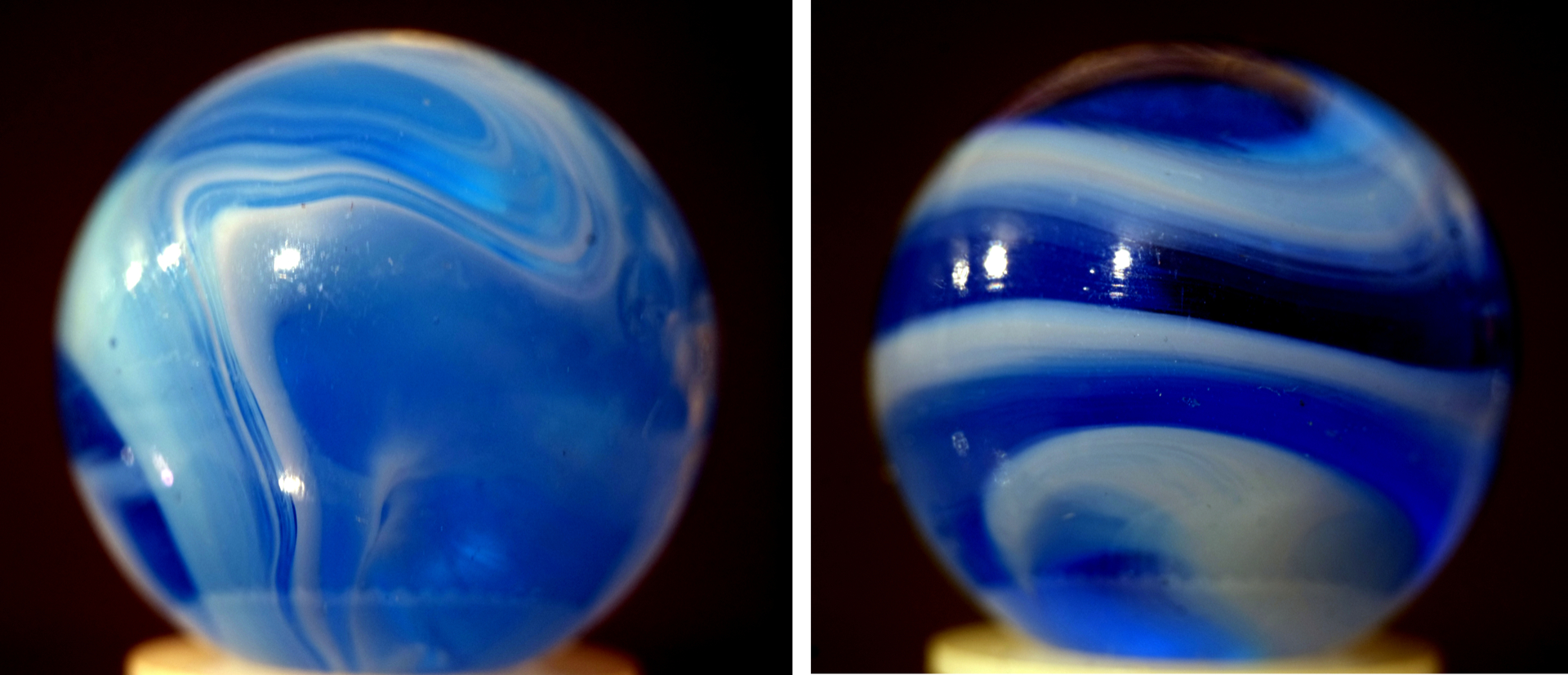 Collectors also seem to like marbles with odd non-primary colors. The four dusty-lavender “Cats-Eye” veins in the one below seem to fill that bill:
Collectors also seem to like marbles with odd non-primary colors. The four dusty-lavender “Cats-Eye” veins in the one below seem to fill that bill:
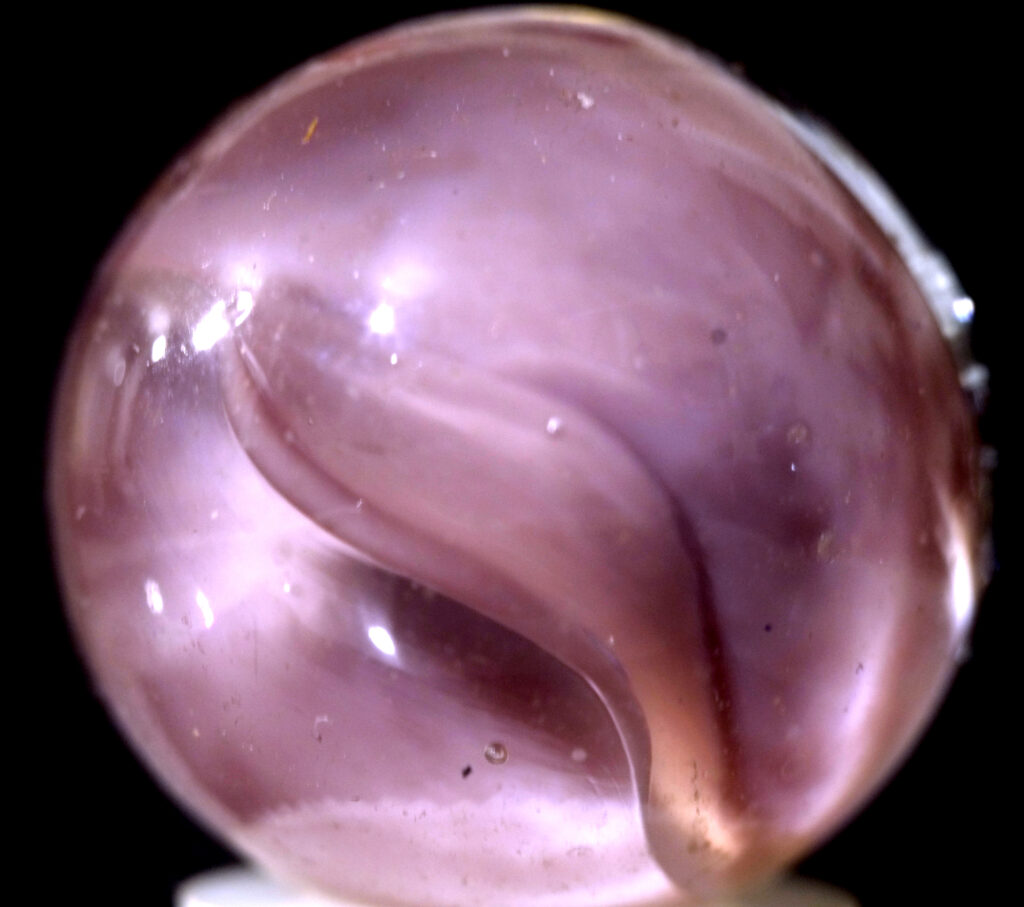 And finally, the last marble in my earlier article was a bit of a mystery. At its small size, it would be called a “peewee.” And the strange yellow thing in its center (left image below) looked creepily like a creature with butterfly wings and a segmented dragonfly or seahorse tail. To its right are two new views captured with this article’s setup:
And finally, the last marble in my earlier article was a bit of a mystery. At its small size, it would be called a “peewee.” And the strange yellow thing in its center (left image below) looked creepily like a creature with butterfly wings and a segmented dragonfly or seahorse tail. To its right are two new views captured with this article’s setup:
 I think that– with 99% certainty– it’s one of Peltier’s “Banana” marbles. I found several Banana shots online that looked totally similar (even to including the brown spots). It’s an unusual Cats-Eye design that sometimes reminds one of the yellow fruit. BUT NOTE: Peltier also slipped non-yellow cores into its “Bananas”!
I think that– with 99% certainty– it’s one of Peltier’s “Banana” marbles. I found several Banana shots online that looked totally similar (even to including the brown spots). It’s an unusual Cats-Eye design that sometimes reminds one of the yellow fruit. BUT NOTE: Peltier also slipped non-yellow cores into its “Bananas”!
Another reason for the marble’s unusual appearance may be that it might have been made with only one “pontil” on its surface (rather than the usual two on opposite sides of common Cat’s Eyes). NOTE: Pontils are places where an artist-designed glass rod is cut off into marble-sized gobs. If a rod’s central “feature” runs continuously through it, then its internal feature will be pinched into gobs with pontils at opposite sides. But if a marble’s central feature doesn’t run continuously through its source rod, it can be pinched into an orb with only one pontil. (At least, that’s my current understanding.)
Some Closing Thoughts
Viewed up-close, marbles are lovely pieces of art! Just like their bigger brothers (which range up to full-fledged paperweights). But I still have a lot to learn about the beautiful orbs in my old jar.
And since most of the marbles one finds at flea markets and yard sales are vintage productions of companies that largely no longer exist, they are growing in value. So much so that one can find many online videos of “marble archeologists” who like to dig around old marble plants and abandoned garbage dumps. Often with great success!
Google, DuckDuckGo and other search engines are great places to research them. But I’ve also discovered how fun it can be to view YouTube videos through Roku (or another streaming service). It proved to be a great way to browse videos about marbles and their hunters. Or about any other topic of interest– including cameras, film, photo techniques, and specific photographers!
That discovery was also a boon for me, since I suffer from insomnia. And researching these marbles on our flat-screen TV was a pleasant way to pass some sleepless nights!
–Dave Powell is a Westford, Mass. writer and avid amateur photographer.
Share this post:
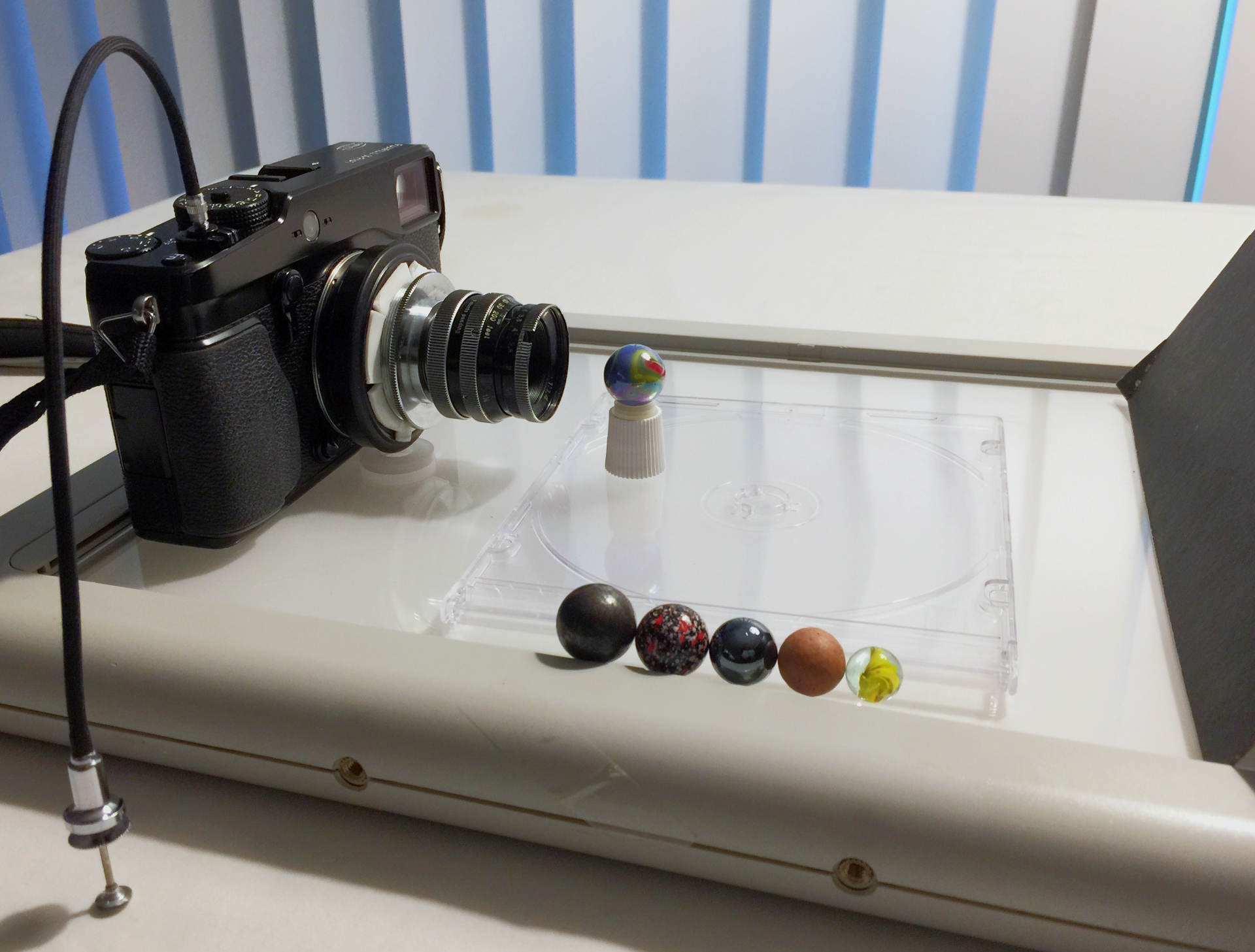
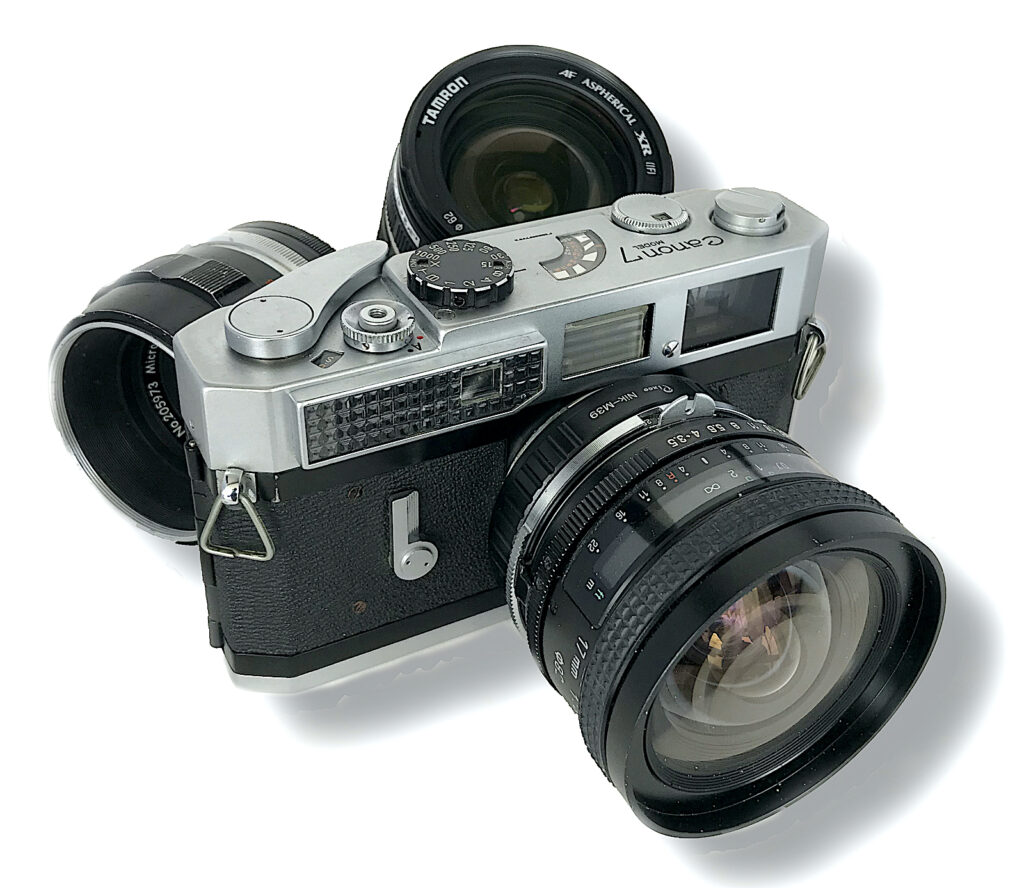
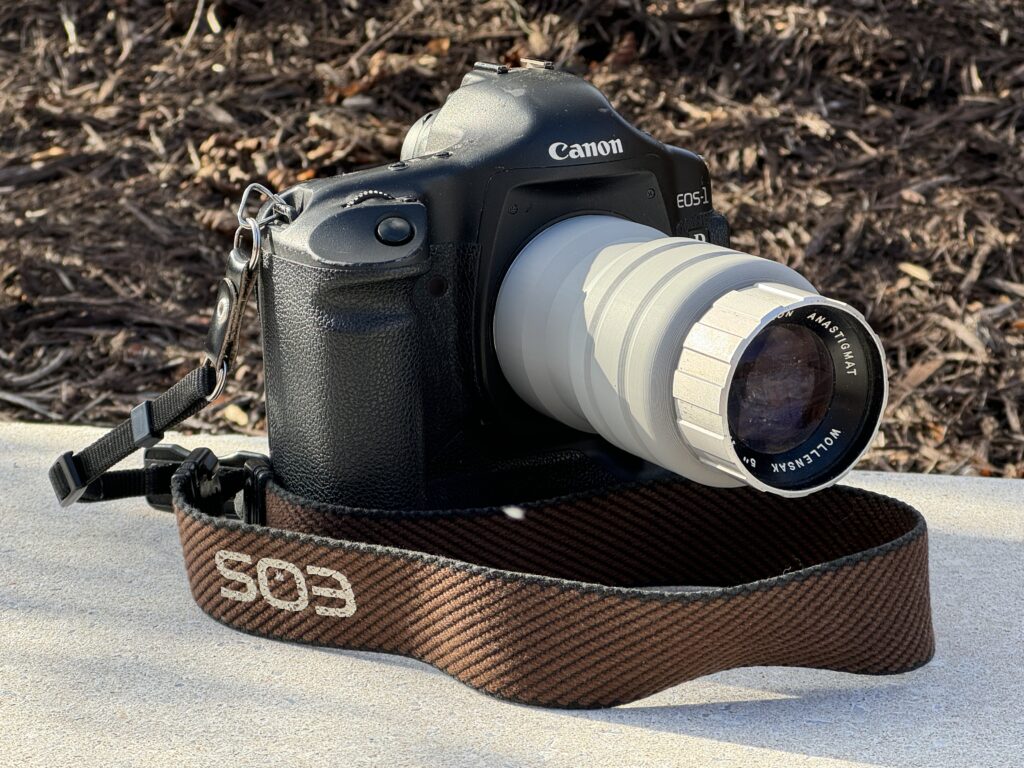
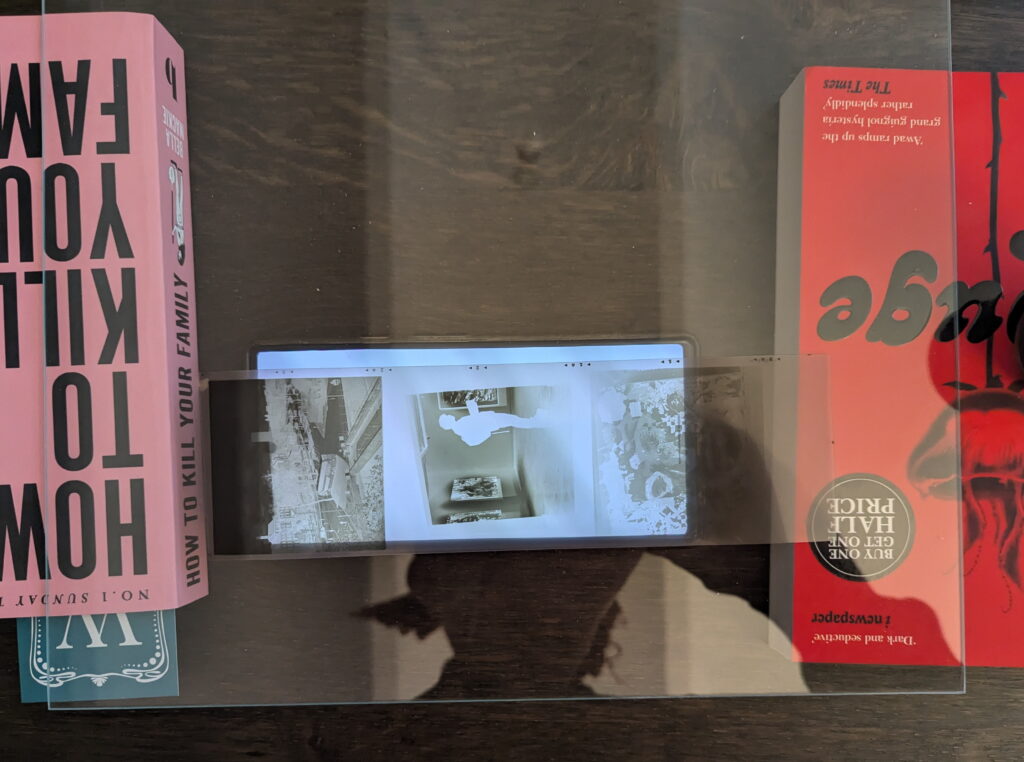
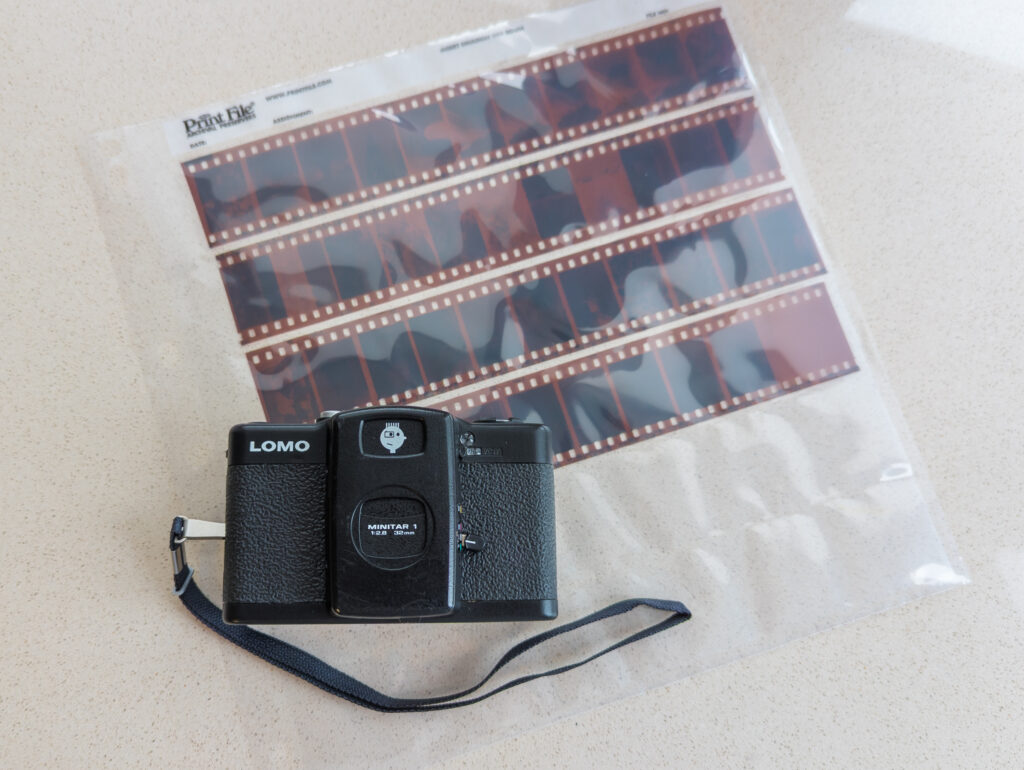




Comments
Michael Zwicky-Ross on More Adventures with C-Mount Marble Macros
Comment posted: 03/10/2024
Comment posted: 03/10/2024
Gary Smith on More Adventures with C-Mount Marble Macros
Comment posted: 03/10/2024
Comment posted: 03/10/2024
Jeffery Luhn on More Adventures with C-Mount Marble Macros
Comment posted: 03/10/2024
I am one of millions that have had a fascination with marbles. In the first through fourth grade, ages 6-10, we played marbles in the school yard when we weren't staring at the older girls on the monkey bars.
Your photos and writing have been a joy to read! Thank you for taking me to visit those little planetoids!
Comment posted: 03/10/2024
Bill Brown on More Adventures with C-Mount Marble Macros
Comment posted: 04/10/2024
Comment posted: 04/10/2024
Cem Eren on More Adventures with C-Mount Marble Macros
Comment posted: 06/10/2024
Comment posted: 06/10/2024
Paul Quellin on More Adventures with C-Mount Marble Macros
Comment posted: 08/10/2024
Comment posted: 08/10/2024